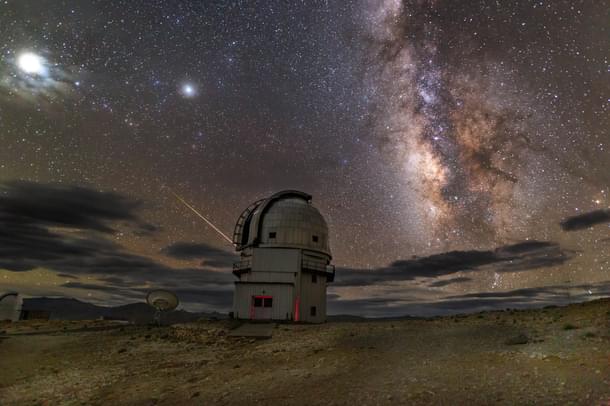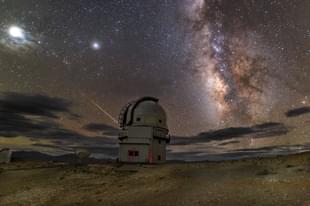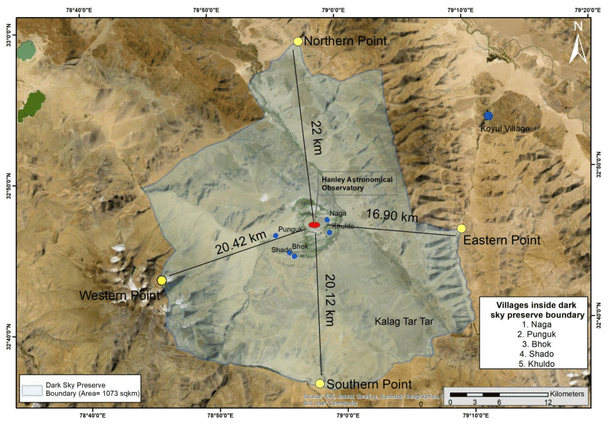Science
India’s First Dark Sky Reserve Is In Hanle, Ladakh — Home To Indian Astronomical Observatory
Karan Kamble
Dec 26, 2022, 06:05 PM | Updated 06:13 PM IST
Save & read from anywhere!
Bookmark stories for easy access on any device or the Swarajya app.


The Hanle Dark Sky Reserve — the first such reserve in India — was officially notified this month.
The sanctuary spreads across 1,073 square kilometres (sq km) of area surrounding the high-altitude Indian Institute of Astrophysics (IIA) facility called Indian Astronomical Observatory (IAO).
At 4,500 metres (m) above mean sea level, the IAO is an impressive and significant IIA station in Hanle, Ladakh.
Hanle is a cold and dry desert at an altitude of over 4,000 m with few people inhabiting the region. For the stark picture that this might paint, it supplies excellent conditions for probing the universe. The cloudless skies and low atmospheric water vapour are particularly beneficial.
The observatory hosts a 2-m optical-infrared telescope, called the Himalayan Chandra Telescope, which is operated remotely using dedicated satellite links, from another IIA facility in Hosakote (CREST), near Bengaluru in Karnataka.
For a little over two decades, the telescope has been scanning the night sky in search of a variety of astronomical objects and events, and helping produce important scientific research.
Besides its more obvious environmental advantages, the IAO offers a benefit unavailable with other IIA facilities down south (Vainu Bappu Observatory, Kodaikanal Solar Observatory, and Gauribidanur Radio Observatory) — the high-altitude station doesn’t have to be powered down on account of the months-long monsoons which affect most of India.
The upper Himalayan region boasts of clear skies because the lower Himalayas take care of the monsoon clouds.
A dark sky — devoid of interference from artificial light — is critical to capturing the cosmos faithfully and developing a better understanding of the wider world around us, which is unspeakably vast.
“Reserves consist of a core area meeting minimum criteria for sky quality and natural darkness, and a peripheral area that supports dark sky preservation in the core,” the International Dark-Sky Association (IDA) says. There are 20 certified IDA international dark sky reserves around the world.
According to the 1 December notification, the night sky sanctuary covers the six hamlets of Hanle, namely, Bhok, Shado, Punguk, Khuldo, and the Naga and Tibetan refugee habitations within the Changthang Wildlife Sanctuary.
The chosen area was identified by Ladakh’s Wildlife Department with inputs from the local community, IIA, and the Ladakh Autonomous Hill Development Council, Leh.

IAO engineer in-charge Dorje Angchuk spearheaded the implementation of the Hanle Dark Sky Reserve project.
“Hanle offers one of the best skies in the world. This is mainly due to being placed at a very high altitude and the number of clear skies that we get there and also the dry condition, which makes it one of the ideal location for an observatory to be placed there,” Angchuk explains in the documentary film Hanle: India's First Dark Sky Reserve, commissioned by the IIA for the Administration of the Union Territory of Ladakh and released at the end of June this year.
The notification of the dark sky reserve will preserve the sanctity of the space for astronomy and astrophysics research as well as wildlife conservation. Specifically, it will help to keep artificial light pollution down, promote livelihoods through eco-friendly astrotourism, spread the word about astronomy to the wider community, and bolster scientific research.
Thanks to the notification of the reserve, restrictions will be placed on vehicular movement at night and care will be taken for outdoor light management within the protected areas. This will help reduce artificial illumination and sky glow.
Curtailing light pollution — a serious global concern with implications for all life — in and around Hanle is now in the hands of the village community members as well as government agencies operating in the area.
The locals especially now have a new way to earn a livelihood as well; examples include running home stays within the realm of responsible tourism and serving as astroguides for starry-eyed visitors.
“This is indeed a great moment for the country. Ladakh is first to notify an area as a dark sky reserve,” IIA Director Annapurni Subramaniam said in a tweet after the announcement was made mid-December, crediting the "Hanle community, Ladakh administration, and IIA Bengaluru" for the "joint initiative."
Karan Kamble writes on science and technology. He occasionally wears the hat of a video anchor for Swarajya's online video programmes.




